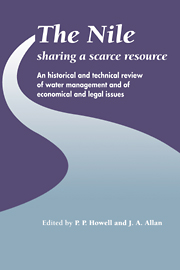 The Nile: Sharing a Scarce Resource
The Nile: Sharing a Scarce Resource Book contents
- Frontmatter
- Contents
- Preface
- List of Contributors
- Orthography
- Units and Conversion Factors
- Introduction
- I Environmental history of the Nile and its management
- II Nile management and factors affecting future management
- III Future utilisation of Nile waters
- 8 Future irrigation planning in Egypt
- 9 Future water development planning in the Sudan
- 10 Irrigation and hydro-power potential. Water needs in Uganda, an overview
- 11 The integrated development of Nile waters
- 12 The control of the swamps of the southern Sudan: Drainage schemes, local effects and environmental constraints on remedial development
- 13 Water balance of the Bahr el Ghazal swamps
- IV Economic, international and legal issues
- Index
8 - Future irrigation planning in Egypt
Published online by Cambridge University Press: 05 February 2012
- Frontmatter
- Contents
- Preface
- List of Contributors
- Orthography
- Units and Conversion Factors
- Introduction
- I Environmental history of the Nile and its management
- II Nile management and factors affecting future management
- III Future utilisation of Nile waters
- 8 Future irrigation planning in Egypt
- 9 Future water development planning in the Sudan
- 10 Irrigation and hydro-power potential. Water needs in Uganda, an overview
- 11 The integrated development of Nile waters
- 12 The control of the swamps of the southern Sudan: Drainage schemes, local effects and environmental constraints on remedial development
- 13 Water balance of the Bahr el Ghazal swamps
- IV Economic, international and legal issues
- Index
Summary
Introduction
The Sudan has yet to utilise its full share of the Nile flows as defined by the 1959 Nile Waters Agreement; Egypt already takes its full allocation. The regional drought during the 1980s has concentrated thinking on methods of improving the efficiency of water use within Egypt. Efficiency requires the maximum re-use of water within the Nile Basin whilst maintaining essential low flows in the Delta to prevent salination. Irrigating areas of the western desert from the Nile offers no potential for re-use of water and is therefore an ‘inefficient’ use. Enterprising private farmers using groundwater or lifting drainage water point the way to increasing re-use. Management problems must also be addressed. The advent of easy-to-use computer simulations of the irrigation system will permit experienced engineers to try out alternative operational procedures.
The problem
In the first ten years of operation after the completion of the High Dam the level in Lake Nasser continually rose and there was some speculation about the possibility that there was more water available than had been envisaged. The 1980s brought us down to earth quickly and dramatically with the Lake dropping to critically low levels by the end of 1987 and the real question of whether this drought condition was a permanent proposition for the future. There was some respite in 1988 but flows were down again by 1989.
- Type
- Chapter
- Information
- The Nile: Sharing a Scarce ResourceA Historical and Technical Review of Water Management and of Economical and Legal Issues, pp. 195 - 204Publisher: Cambridge University PressPrint publication year: 1994
- 3
- Cited by


